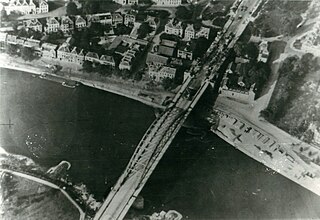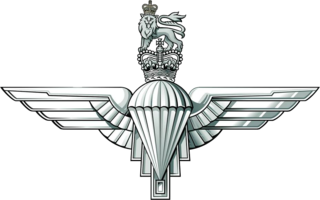
Operation Market Garden was an Allied military operation during the Second World War fought in the German-occupied Netherlands from 17 to 25 September 1944. Its objective was to create a 64 mi (103 km) salient into German territory with a bridgehead over the Nederrijn, creating an Allied invasion route into northern Germany. This was to be achieved by two sub-operations: seizing nine bridges with combined US and British airborne forces ("Market") followed by British land forces swiftly following over the bridges ("Garden").

The Battle of Arnhem was a battle of the Second World War at the vanguard of the Allied Operation Market Garden. It was fought in and around the Dutch city of Arnhem, the town of Oosterbeek, the villages Wolfheze and Driel and the vicinity from 17 to 26 September 1944. The Allies were poised to enter the Netherlands after sweeping through France and Belgium in the summer of 1944, after the Battle of Normandy. Operation Market Garden was proposed by Field Marshal Sir Bernard Montgomery, who favoured a single push northwards over the branches of the Lower Rhine River, allowing the British Second Army to bypass the Siegfried Line and attack the Ruhr. US Airborne troops were dropped in the Netherlands to secure bridges and towns along the line of the Allied advance. Farthest north, the British 1st Airborne Division landed at Arnhem to capture bridges across the Nederrijn, supported by men of the Glider Pilot Regiment and the 1st Polish Parachute Brigade. The British XXX Corps were expected to reach the British airborne forces in two to three days.

Operation Pegasus was a military operation carried out on the Lower Rhine near the village of Renkum, close to Arnhem in the Netherlands. Overnight on 22–23 October 1944, Allied military forces, Britain's MI9 intelligence organization, and the Dutch Resistance evacuated 138 men, mostly soldiers trapped in German-occupied territory who had been in hiding since the Battle of Arnhem a month earlier.

The Parachute Regiment, colloquially known as the Paras, is the airborne and infantry regiment of the British Army. The first battalion is part of the Special Forces Support Group under the operational command of the Director Special Forces. The other battalions are the parachute infantry component of the British Army's rapid response formation, 16 Air Assault Brigade. The Paras, along with the Guards, are the only line infantry regiment of the British Army that has not been amalgamated with another unit since the end of the Second World War.

John Daniel Baskeyfield was a British Army soldier and an English recipient of the Victoria Cross (VC), the highest award for gallantry in the face of the enemy that can be awarded to members of the British and Commonwealth armed forces.

Captain John Hollington Grayburn VC was an English recipient of the Victoria Cross, the highest and most prestigious award for gallantry in the face of the enemy that can be awarded to British and Commonwealth forces.
David Samuel Anthony Lord, was a recipient of the Victoria Cross, the highest award for gallantry in the face of the enemy that can be awarded to British and Commonwealth forces. A transport pilot in the Royal Air Force, Lord received the award posthumously for his actions during the Battle of Arnhem while flying resupply missions in support of British paratroops.

Groesbeek Canadian War Cemetery and Memorial is a Second World War Commonwealth War Graves Commission military war grave cemetery, located in the village of Groesbeek, 8 km (5.0 mi) southeast of Nijmegen in the Netherlands. Of the total 2,619 burials, the cemetery contains 2,338 Canadian soldiers. It was built to a design by Commission architect Philip Hepworth.

Operation Anger was a military operation to seize the city of Arnhem in April 1945, during the closing stages of the Second World War. It is also known as the Second Battle of Arnhem or the Liberation of Arnhem. The operation was part of the Canadian First Army's liberation of the Netherlands and was led by the 49th British Infantry Division, supported by armour of the 5th Canadian Armoured Division, Royal Air Force air strikes and boats of the Royal Navy.

The 4th Parachute Brigade was an airborne, specifically a parachute infantry, brigade formation of the British Army during the Second World War. Formed in late 1942 in the Mediterranean and Middle East, the brigade was composed of three parachute infantry units, the 10th, 11th and 156th Parachute Battalions.

The Airborne Museum ‘Hartenstein’ in Oosterbeek, The Netherlands is dedicated to the Battle of Arnhem in which the Allied Forces attempted to form a bridgehead on the northern banks of the Rhine river in September 1944. Hartenstein served as the headquarters of the British 1st Airborne Division. In the museum an extensive and diverse collection is displayed consisting of original weaponry, genuine uniforms and equipment used in the battle. The numerous photos and films on display provide a realistic picture which is enhanced by interviews with Allied soldiers. In addition the museum has an award-winning Airborne Experience exhibition, that depicts the area around Arnhem and Oosterbeek during the battle. The museum also provides German and civilian perspectives.
Operation Berlin was a night-time evacuation of the remnants of the beleaguered British 1st Airborne Division, trapped in German-occupied territory north of the Lower Rhine in the Netherlands during Operation Market Garden in the Second World War. The aim of the operation was to withdraw safely the remnants of the division while covered by the 1st Polish Parachute Brigade and surrounded on three sides by superior German forces and in danger of being encircled and destroyed.

Major Robert Henry Cain VC TD was a Manx recipient of the Victoria Cross, the highest award for gallantry in the face of the enemy that can be awarded to British and Commonwealth forces.

Colonel John Llewellyn Waddy, was a British Army officer who served during the Second World War, in Palestine and during the Malayan Emergency, before becoming Colonel of the SAS.

Lieutenant Colonel Richard Thomas Henry Lonsdale, was an officer of the British Army who served with the Parachute Regiment throughout much of the Second World War.
During World War II, the Netherlands was the scene of five years of continuous air warfare between the Allied and the Nazis as the Netherlands lies en route from England to Germany and was designated and built up as the foremost line of Nazi air defence of Germany. Also, in 1944 there was heavy land fighting during the largest Allied airborne attack of the WWII in the south and east of the country in 1944–45. Thousands of airmen, soldiers and others of many nations were killed, and their war graves in some 4,000 locations are in the care of the Dutch War Cemetery Organisation.
Major Robert Laslett John Pott MBE MC was a British Army officer who, during World War II, served as Commanding Officer of A Company, 156th Battalion, Parachute Regiment, in the Battle of Arnhem, part of Operation Market Garden, in September 1944. Sixty-five years after the Battle of Arnhem, John Pott's story became more widely known because of a song written about him by his grandson, Joel Pott, lead singer of the Ivor Novello Award winning indie rock band Athlete.

The 10th Battalion, The Parachute Regiment was an airborne infantry battalion of the Parachute Regiment, originally raised as the 10th (Sussex) Battalion by the British Army during the Second World War.

The Battle of Nijmegen, also known as the Liberation of Nijmegen, occurred from 17 to 20 September 1944, as part of Operation Market Garden during World War II.

The Jonkerbos War Cemetery and Memorial is located in the town of Nijmegen, Netherlands. The cemetery contains 1,643 British Commonwealth and foreign service personnel of World War II. It was built to a design by Commission architect Philip Hepworth.



















